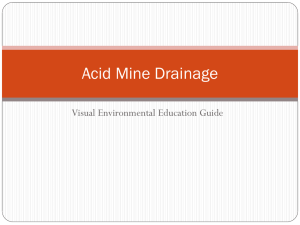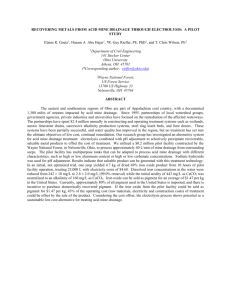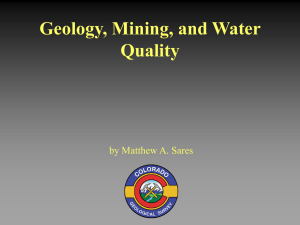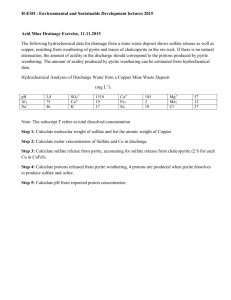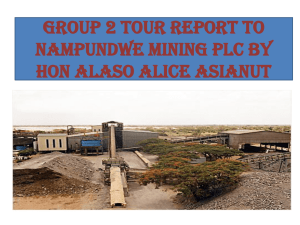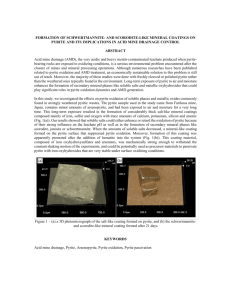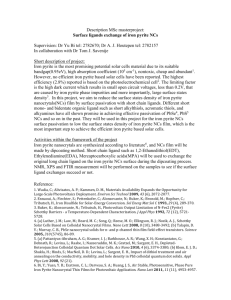Acid Mine Drainage. Yeah. - Civil & Environmental Engineering
advertisement
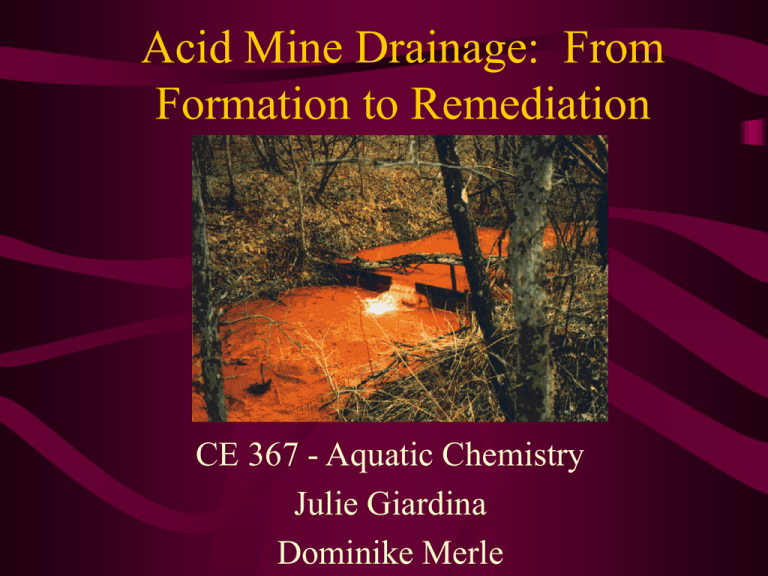
Acid Mine Drainage: From Formation to Remediation CE 367 - Aquatic Chemistry Julie Giardina Dominike Merle Introduction: What is Acid Mine Drainage (AMD)? • Highly acidic water with elevated levels of dissolved metals. • Drainage from surface or deep coal or metal mines and coal refuse piles. • An important environmental issue in many areas where mining has taken place. Sources of Acid Mine Drainage • Mining of gold, silver, copper, iron, zinc, lead (or combined metals), and coal – Past and present – During exploration, operation, and closure of mine, from the mine’s: • dewatering system • tailings disposal facilities • waste heaps – Water table rebound after pumping equipment is removed. Process of Acid Mine Drainage • Geochemical and microbial reactions during weathering of sulfide minerals (pyrite) in coal, refuse, or mine overburden – Oxidation of sulfide minerals in the presence of air, water, and bacteria – Formation of sulfuric acid and increase in acidity – Solubilization of metals due to low pH A Side Note: Acid Rock Drainage • Formation of acidic waters – Occurs naturally due to weathering of sulfide minerals in rocks – Occurs at a much slower rate Effects of Acid Mine Drainage • Water resources – Increased acidity – Depleted oxygen – Increased weathering of minerals release of heavy metals/toxic elements into stream – Precipitation of Fe(OH)3 bright orange color of water and rocks Effects of AMD (cont’d) • Biological resources – Low pH and oxygen content water unsuitable for aquatic life – Precipitation of Fe(OH)3 • Increased turbidity and decreased photosynthesis • Gill-clogging, smothering of bottom dwellers and food supply, and direct toxicity (benthic algae, invertebrates, and fish) • Clogging of interstitial pore space in coars aquatic substrate habitat Effects of AMD (cont’d) • Biological resources – Elimination of aquatic plants change in channel hydraulics – Stress on other biota associated with aquatic habitats • Human resources – Corrosion of pipes, pumps, bridges, etc. – Degradation of drinking water supplies – Harm to fisheries Chemistry of Acid Mine Drainage Reaction 1 2FeS2 + 7O2 + 2H2O 4Fe 2+ + 4SO4 + 4H+ • weathering of pyrite in the presence of oxygen and water to produce iron(II), sulfate, and hydrogen ions Reaction 2 4Fe2+ + 7O2 + 2H2O 4Fe3+ + 2H2O • oxidation of Fe(II) to Fe(III) • rate determining step Chemistry of AMD (cont’d) Reaction 3 2Fe3+ + 12H2O 4Fe(OH)3 + 12H+ • hydrolysis of Fe(III) • precipitation of iron(III) hydroxide if pH > 3.5 Reaction 4 FeS2 + 14Fe3+ + 8H2O 15Fe2+ + 2SO42- + 16H+ • oxidation of additional pyrite (from steps 1 and 2) by Fe(III) -here iron is the oxidizing agent, not oxygen • cyclic and self-propagating step Chemistry of AMD (cont’d) Overall Reaction 4FeS2 + 15O2 + 14H2O 4Fe(OH)3 + 8H2SO4 Typical Case: Manila Creek, VA • Iron content:567 mg/L, pH:3.5, flow from mine of 42GPM. • Wetlands were used to increase pH. • pH increased to 5.1, iron contents reduced to 67 mg/L. Extreme Case: Iron Mountain, Ca • Extreme pH measurements from 1.51 to –3.6 over a temperature range of 29-47oC. • Total iron from 2.67 to 141 g/L. • SO4: 14-50 g/L • Zn: 0.058-23 g/L. • Regulatory actions initiate to increase pH and reduce metal concentrations. Remediation • Use of acid generating rocks to segregate/blend waste. • Bacteria Desulfovibrio and Desulfotomaculum – SO4-2 + 2 CH2O = H2S + 2 HCO3- • Alkaline Materials (CaCO3, NaOH, NaHCO3, anhydrous ammonia). – CaCO3 + H+ = Ca+2 + HCO3 • Soil, clay, synthetic covers. • Chemical additives Remediation Procedures Future/Ongoing Research • Prediction of acid generation – Acid\base accounting – Weathering tests – Computer models • Prevention/Mitigation – – – – Rock phosphate to inhibit pyrite oxidation. Coatings and sealant to inhibit acid production. Improve time for bactericide leaching. Encapsulation of pyrite material. Conclusions • AMD is an environmental problem results from the oxidation of pyrite by bacteria air, and water. • Oxidation of pyrite decrease pH and increase concentrations of dissolve metals in water. • The latter results in the pollution of water, which can be harmful for the environment and living species. • Several methods such as wetlands have been done to increase pH and decrease metal concentrations in water. • AMD research continues in order to find better ways to mitigate pollution and reduce the overall effects in the environment such as global warming.

